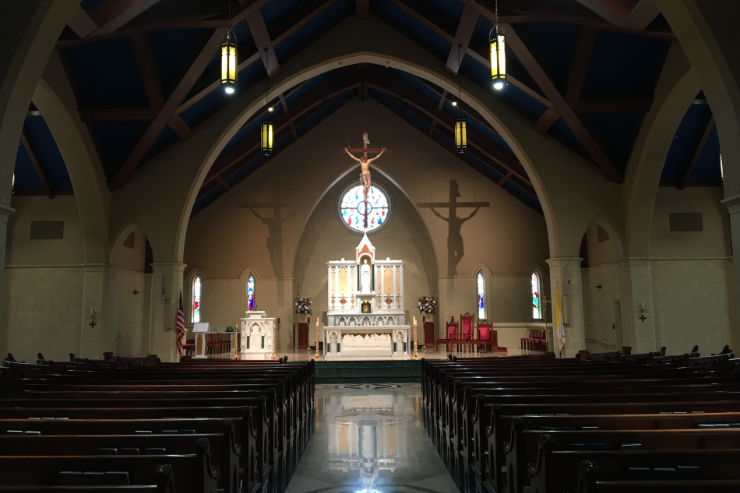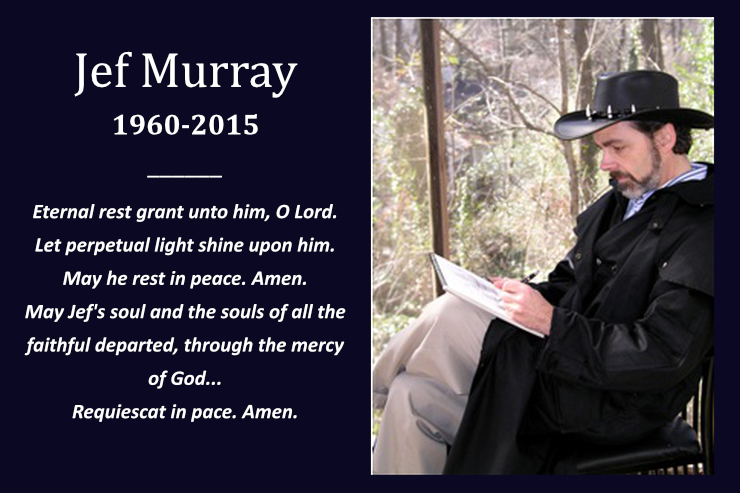
St. Peter Chanel Catholic Church, Roswell, Georgia—Photography © by Michael Bickerstaff
I was recently making a retreat at a Monastery in the Catskills. At Sunday Mass, I was asked by the Chaplain to distribute the Precious Blood to the nuns and lay people in attendance. At one point there was a little delay as I was giving the Chalice to the lay guests; the priest Celebrant, distributing the Sacred Hosts, was having a brief conversation, inaudible to me, with two women in line.
After Mass, as I was heading to the tribune to make my Thanksgiving, one of the women met me and told me how upset she was that the Chaplain had asked her adult daughter (who was probably special needs, although nothing in her physical appearance indicated it) whether she was Catholic before giving her Holy Communion.
“Do you know if she did anything to make the priest presume that she might not be Catholic,” I asked, to which she replied, “I don’t understand why he should even want to know. Aren’t we all children of God? It was just so embarrassing.”
Since retreatants at this Monastery have to sign a “covenant” of strict silence, I led the two women into a small meeting room and closed the door. “I’m really sorry you and your daughter were embarrassed,” I whispered to her, “and please know that priests hate to embarrass anyone, especially at the sacred time of Holy Communion, but we have a holy duty with regard to Jesus’ Body and Blood. If the way someone approaches to receive Communion raises a serious question as to whether the person is not Catholic, we have to ask.” I mentioned to her that the Chaplain obviously went to great lengths not to embarrass, since I couldn’t even hear what he said from a few feet away and that once her daughter confirmed she was Catholic, he immediately gave her Communion.
It led to a tranquil conversation about the why-behind-the-what of the Church’s practice, about the reasons Holy Communion is given only to rightly disposed Catholics (with a few exceptions listed in canon law), about how priests generally approach these situations, and about how to help her daughter comport herself at Communion time so that she would not be asked again. The woman thanked me for spending the time with her and concluded, “Father, we just don’t know these things. It would be great if the Church told us so that we could avoid these embarrassments.”
Her sincere last words stuck with me for a while during my retreat. What I had conveyed to her was practical information that most Catholic third graders know about how to receive Holy Communion, but to her it seemed to be a revelation. In some places Catechesis on Holy Communion is just not done as clearly as in others, sadly leaving parishioners in potentially embarrassing situations when they travel.
I remember once at St. Francis Xavier Parish in Hyannis when a clean-cut teen in suit and tie approached, bowed his head, made a cruciform throne in his hands, said “Amen,” but just started walking away without making the slightest attempt to place the Host in his mouth. I watched him to see whether he would communicate but as he turned the aisle to head to his pew, I could still see the Eucharist in his hands. So I followed him to where he was kneeling, still with the host in his hands, with his eyes closed. “Sir, please receive Jesus now,” I whispered to him. Startled to see the priest next to him, he immediately did so. I encouraged him to come to see me after Mass so that we could talk.
When he approached, he apologized and questioned whether he had done anything wrong. I asked him why he hadn’t communicated immediately after receiving. “In my parish,” he replied, “the priest has all of us return to the pews with the Host until the last person has gotten back. Then all of us, together with the priest, receive at the same time. Is that not the way Catholics are supposed to do it?” I told him no, explained how Catholics are supposed to receive right away, and asked for his pastor’s name in Missouri so that I could speak to him.
When I reached the priest on the phone, I asked him why he trained his people to receive in a way other than basic Catholic practice. He said that he thought it was “beautiful symbolism,” a liturgical version of table manners, to wait to eat until everyone had received food on his or her plate. “Do you realize, however, that when your parishioners travel to any other parish for Mass, they might be put into inconvenient situations?,” I queried. He said he honestly hadn’t thought about that. I urged him to bring his practice into harmony with the Church’s at least for that reason.
There are some basic things that Catholics need to know to avoid any embarrassment at Communion time.
First, how should a Catholic receive? We should make a sign of reverence to Jesus (normally a profound bow at the waist or at least of the head while the person ahead receives), say “Amen” to the words “The Body of Christ,” if we’re receiving on the tongue, open one’s mouth and extend one’s tongue over the lower lip, or, if one is receiving on the hands, place the palms of the hands in the form of a cross at about the level of the sternum and, having received Jesus on the top hand, step to the side, take the lower hand and with it place Jesus in the mouth. When someone doesn’t say “Amen,” doesn’t open one’s mouth, doesn’t extend hands at all, or extends just one, or reaches for the host with thumb and index finger, or other such anomalies, the Minister may legitimately wonder whether the person is Catholic or has ever been trained properly to make first Communion.
Why would a Catholic priest ever risk embarrassing anyone at Communion time? The simple answer is because we’re dealing with Jesus Christ and we love him. Just as we wouldn’t hand our baby to a stranger or give our greatest valuables to someone who doesn’t know how to handle them with care, we won’t give Jesus to someone who has given us reason to doubt whether he will be treated with supreme reverence.
Many Catholic priests have made the sad discovery of hosts in Missalettes and in the pews. I also once had a converted Satan worshipper in New Bedford tell me how in the local coven they would desecrate hosts easily taken from area Churches whose Eucharistic Ministers were not vigilant.
We’re not trying to embarrass anyone — in fact, most of us hate to be in situations where we have to ask — but we do have the basic duty out of love to guard the Eucharist. The Church clearly instructs us, “Special care should be taken to ensure that the host is consumed by the communicant in the presence of the minister, so that no one goes away carrying the Eucharistic species in his hand” (Redemptionis Sacramentum 92) In the early Church, St. Tarcisius died protecting the Eucharist from a bunch of thugs seeking to desecrate him, and one of the minimal requirements for a Minister of Holy Communion is a commitment to prevent Jesus from being desecrated, even at the risk of our life. And if we reluctantly have to risk hurting someone’s feelings to fulfill that responsibility of love, we will. We must.
There are obviously better or worse ways to do this, but sometimes no matter how sensitive a priest is, the very fact that he does his job and asks whether someone is Catholic, or does not give Holy Communion to someone the Church clearly teaches should not receive, is deemed offensive.
Most often that flows because Jesus in the Eucharist is not regarded with adequate reverence. Some Catholics have such a soft image of Jesus that they behave as if he wouldn’t possibly want not to be given in Holy Communion to unrepentant serial killers, to our cousin who hasn’t graced the inside of a Church in decades, to those who approach drunk or stoned, or to non-Catholics or non-Christians who, not knowing any better, come to receive him just because they see everyone else doing so. Others treat the Eucharist like cake at a birthday party and deem that rules of hospitality should dictate that everyone who desires, no matter the circumstances, should get a slice.
Some pastors have also irresponsibly confused people by saying that, contrary to what canon law prescribes, all are welcome in the Communion line and that they would never under any circumstances refuse anyone Holy Communion. One wonders if a person approached dressed in a devil’s outfit explicitly stating he wanted a host for desecration or dragging someone’s fresh corpse, whether such clergy would then obediently say and do what the Church demands and reverence requires.
The point is that we’re not dealing with a thing, even with the holiest thing in the world. We’re dealing, rather, with the Eternal Son of God. And though we want, as Jesus does, everyone to come into communion with Him and with us (1 John 1:3), the Church teaches that receiving him in Holy Communion is not the first step in, but the fruit of, that communion of life. It is the consummation of the spousal union between Christ and his Bride the Church. And as we see in human relationships, if the order between entering the covenant and consummating it is inverted, what should be supremely enriching can in turn become harmful, spiritually and otherwise.
The Church’s wisdom and practice with regard to Holy Communion are far from arbitrary rules of inclusion and exclusion but ultimately directed to the reverence and love of God and the salvation and sanctification of all.
This article originally appeared in The Anchor, the weekly newspaper of the Diocese of Fall River, Mass, on August 25, 2017 and appears here with permission of the author.













